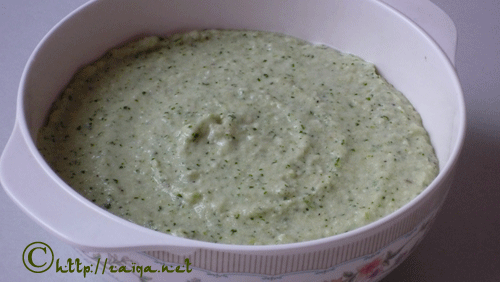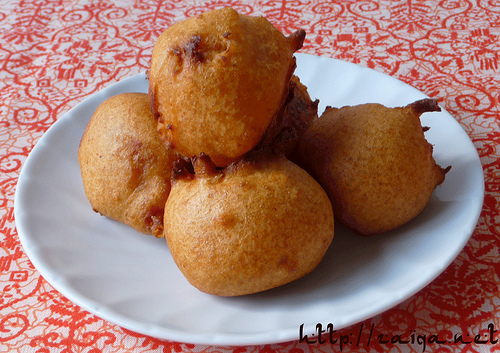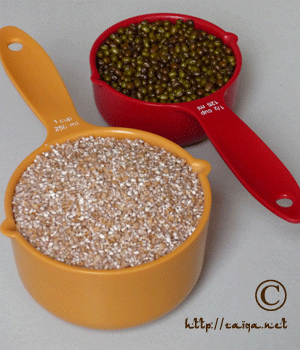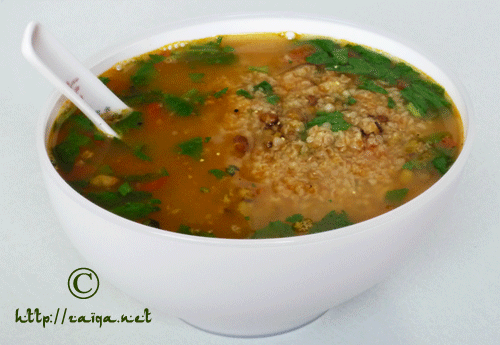‘Baghare Baingan’ (in Urdu) when translated into english language means ‘Tempered Eggplants’. Baghaar or tempering is an Indian process of flavoring the oil with spices which is used in the preperation of a curry to impart added taste and aroma.
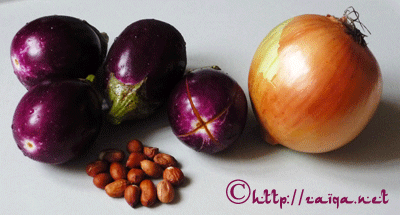
Aubergines, Peanuts and a large sized Onion (One of the Aubergines has an ‘X’ shaped incision at its base)
This is a lovely and delicious brinjal side dish, a hallmark and peculiar to the state of Hyderabad, usually seen being served at Daawat – weddings, parties and large gatherings. It is generally had as a side dish along with Biryanis or some people even enjoy it along with a Roti/Paratha.
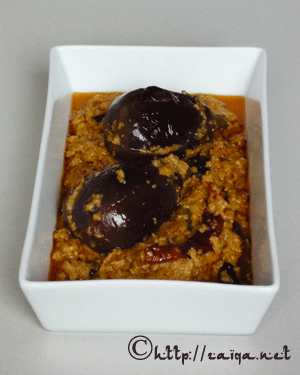
Baghare Baingan – Tempered Aubergines in a rich Sauce
The eggplants are cooked twice, once they are shallow fried and then later simmered in a fragrant sweet and spicy sauce of sauteed onions and roasted spices. The tamarind imparts a tangy kick to the sauce consisting of roasted nutty and buttery peanuts, poppy seeds and coconut, a range of aromatic spices and caramelized onions.
Only Indian eggplants that are small, shiny deep purple and fresh are used for this curry. These are easily available at many Indian stores. Brinjal/Eggplant/Aubergines or Baingan are not a favorite of many people, but I suggest you all try this dish once and you will definitely love it. It is one of the best aubergine dishes I have ever had.
The procedure to prepare Mirchi Ka Salan or Tamatar ka Salan is also almost the same as this curry. Also, you can also add any firm fish fillets (Red snapper, Haddock, Cod, etc) to the gravy instead of brinjal to make it a fish curry/Machli ka Salan; or halved tomatoes to the gravy to make it Tamatar ka Salan. There is no difference, except for the fact that in Mirchi ka Salan, green chillies are used; in tomato curry, tomatoes are used; in fish curry, fish fillets are used; and in this curry, the brinjals are used.
Baghare Baingan – Tempered Aubergines in a Spicy Nutty Tangy Sauce
Cooking time: around 45 minutes; Serves: 6
Ingredients:
Eggplants/Baingan – 6-8, indian variety~small sized, fresh, and deep purple in colour
For dry masala paste:
Khus Khus/White Poppy seeds – 1 tbsp
Till/Sesame Seeds – 1/2 cup/50 gms
Peanuts/Groundnuts/MoomPhalli – 1/2 cup/50 gms
Dry Desiccated Coconut – 3/4 cup/50 gms
Coriander seeds/Dhania – 1 tsp
Cumin seeds/ Zeera – 1 1/2 tsp
For baghaar/tempering:
Cumin seeds/ Zeera – 1 tsp
Curry leaves/ Kariyapaak – 2 sprigs
Mustard seeds/ Rai – 1/2 tsp
Nigella seeds/ Kalaunji – 1/3 tsp
Fenugreek seeds/ Methi dana – 1/8 tsp
For gravy:
Canola oil
Yellow Onions – 4, large, sliced slightly thick into semi circular rings
Ginger garlic paste – 2 tsp
Salt – 1 tbsp
Red Chilli Powder – 2 tsp
Turmeric/ Haldi – 1/4 tsp
Cilantro/ Kothmir – 2 tbsp, finely chopped
Thick tamarind pulp – 4 tbsp
Method:
1. Wash the eggplants and make four incisions, perpendicular cuts (an X) from the base of each eggplant, taking care the stem end is intact. Soak them in a bowl of cold water with 1tbsp salt to prevent discoloration. Keep aside. In a kadai pour oil to deep fry. When the oil is hot, drain the brinjals. Deep fry the brinjals for about 10-15 minutes until they are tender and well cooked. Gently remove them in a platter and keep aside.
2. Heat a small non-stick frying pan or a cast iron skillet at medium high heat and once it is hot, dry roast the desiccated coconut, sesame seeds, khus khus, peanuts, coriander seeds and cumin seeds, all one by one separately for just 2-3 minutes until they are a few shades darker and remove them into separate bowls. Do not burn the spices. Once cool, rub off the skins of the peanuts. Grind them all separately in a spice grinder to a fine powder or a smooth paste without adding any water and keep aside.
3. Heat a large non-stick frying pan or a cast iron skillet at medium high heat, and as soon as it warms up add the sliced onions. Let the onions sweat and keep stirring them until they are just starting to brown up. Once the onions are soft and lightly browned in color, remove them to a platter and keep aside. Once the dry roasted onions are cool, puree them in a grinder until smooth. Keep aside.
4. Heat 1/4 cup oil in a heavy non-stick pan at medium heat and as soon as it is warm, add the ingredients under the heading ‘for baghaar’ – cumin seeds, mustard seeds, curry leaves, nigella seeds and fenugreek seeds. Let the spices splutter for a minute. Then add the pureed roasted onion paste and immediately cover the pan with a lid for a minute. Lower the heat to medium low and shake the pan to thoroughly mix. This is done for the mixture to absorb all the flavour from the baghaar(tempering). Uncover, lower the heat and add ginger garlic paste and fry for 3-4 minutes. Add the desiccated coconut paste, sesame seed paste, khus-khus paste and peanut paste and stir fry it for 2-5 minutes or until you see that the mixture comes together and starts leaving oil. Add the red chilli powder, salt and turmeric. Mix well and keep stir frying it for a further 2 minutes on medium low heat. Once the raw odor of the peanuts, ginger-garlic paste and coconut is no longer coming, add the dry roasted coriander and cumin seed powder and chopped cilantro and mix well. Pour in 3 1/2 cups warm water and the tamarind pulp. Mix well. Add the fried brinjals and stir. Cover the lid and let cook on simmer for 20-25 minutes while stirring frequently, until the oil has all separated and the brinjals are soft and completely done in the masala gravy. Remove from heat and serve the curry along with Pulao or Biryani or Naan.
Suggested Accompaniments: Biryani, Roti, Paratha
Varieties of Eggplant
This goes to the Monthy Mingle event currently being hosted by Ruth. The theme this time is Sensational Sides, and Baghare Baingan fits perfectly for the title of the event.
Inshallah my next post is going to be the round up for RCI:Authentic Hyderabadi Cuisine which I will publish in just a few days from now. So keep checking on it. Take care of yourselves everyone and Have a good weekend!
Luv,
Mona




